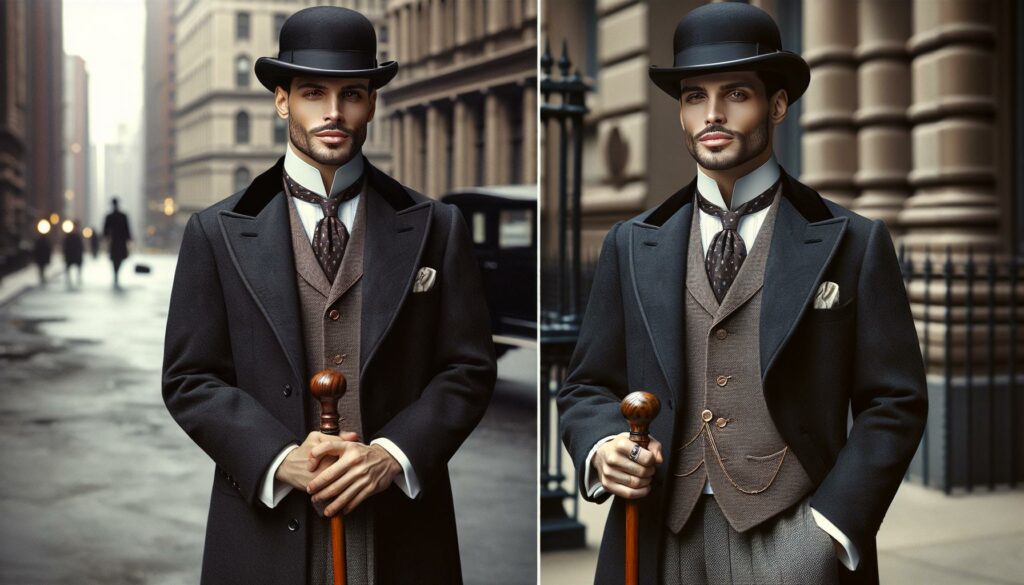I’ve always been fascinated by the elegant and sophisticated men’s fashion of the 1910s. This era marked a significant transition in menswear as society moved from the stiff Victorian styles to more practical and comfortable clothing options. The decade’s fashion reflected the growing modernization of society while maintaining the refined sophistication of a gentleman.
When I explore 1910s men’s fashion I’m struck by the emphasis on impeccable tailoring and attention to detail. Men’s wardrobes typically included morning coats sack suits and formal evening attire. Dark colors dominated the palette with subtle patterns adding visual interest. The iconic look featured high-collar shirts stiff detachable collars and carefully coordinated accessories like pocket watches bowler hats and walking sticks.
Key Takeaways
- The 1910s marked a transition from Victorian stiffness to more practical menswear while maintaining sophistication through impeccable tailoring and attention to detail
- Social class heavily influenced fashion choices, with upper classes wearing fine wool and silk in dark colors, while working classes opted for durable cotton and canvas in earth tones
- Essential menswear pieces included morning coats, sack suits, stiff-collared shirts, high-waisted trousers, and formal accessories like pocket watches and walking sticks
- The color palette centered on dark, muted tones like black, navy, and charcoal for business wear, with lighter shades reserved for summer and sporting activities
- Popular fabrics included worsted wool, heavyweight serge, fine broadcloth, and cotton twill, each serving specific purposes in a gentleman’s wardrobe
- Many 1910s fashion elements continue to influence modern menswear, particularly in formal wear, suit construction, and classic design principles
1910s Mens Fashion
The Edwardian era (1901-1910) shaped the fashion landscape of the 1910s through its emphasis on social refinement and elegant dress codes. The period’s influence carried forward distinct style elements that defined early 1910s menswear.
Social Class and Dress Code
Upper-class gentlemen wore morning coats for daytime activities and full dress tailcoats for evening functions. Middle-class men adopted the sack suit as their primary business attire, while working-class individuals wore sturdy work wear consisting of:
- Cotton shirts with soft collars
- Durable wool trousers
- Heavy-duty boots
- Flat caps or bowler hats
The distinction between social classes manifested in fabric quality, with:
| Social Class | Typical Fabrics | Common Colors |
|---|---|---|
| Upper Class | Fine wool, silk | Black, navy |
| Middle Class | Wool, tweed | Brown, gray |
| Working Class | Cotton, canvas | Earth tones |
The Declining Formality
The strict dress codes of the Edwardian era began to relax by 1912, introducing several notable changes:
- Shorter jackets replaced traditional long frock coats
- Soft collars appeared alongside stiff detachable ones
- Looser-fitting trousers gained popularity over slim cuts
- Sport coats emerged as casual alternatives to formal suits
- Ready-made suits for business
- Casual jackets for weekend activities
- Softer shirt collars for comfort
- Less elaborate accessories
Essential Menswear Pieces of 1910
The 1910s male wardrobe consisted of specific garments that defined the era’s sophisticated style. Each piece served a distinct purpose in a gentleman’s daily attire, from formal occasions to business meetings.
Suits and Jackets
A gentleman’s wardrobe in 1910 featured three main jacket styles: the morning coat, sack suit, and frock coat. Morning coats had a curved cutaway front with peaked lapels in black or oxford gray wool. Sack suits came in navy, charcoal or brown worsted wool with natural shoulders and three buttons. The frock coat extended to the knee with silk-faced lapels, reserved for formal daytime events.
Shirts and Neckwear
Dress shirts in 1910 featured stiff, detachable white collars reaching 3 inches in height. The shirts themselves came in white cotton with starched fronts and french cuffs secured by gold or mother-of-pearl cufflinks. Neckwear options included:
- Four-in-hand ties in silk twill
- Bow ties for formal evening wear
- Ascots for morning dress
- Stock ties for sporting activities
Trousers and Footwear
Trousers maintained a high waist with suspender buttons and straight legs. Key trouser styles included:
- Morning suit striped trousers in gray and black
- Matching sack suit trousers with pressed creases
- Light-colored flannel trousers for sports
- Black cap-toe oxford shoes for business
- Patent leather pumps for evening wear
- Two-tone leather boots for casual settings
- Button boots in black calfskin for formal occasions
Popular Accessories and Hats
The 1910s men demonstrated their social status through carefully selected accessories that enhanced their formal attire. Each accessory served both a functional purpose and acted as a symbol of refinement.
Walking Sticks and Watches
Walking sticks featured polished wood handles, sterling silver caps, or ivory detailing, marking a gentleman’s social position. Notable walking stick varieties included:
- Malacca canes with curved handles for daily use
- Ebony sticks with gold caps for formal occasions
- Bamboo canes with carved designs for casual outings
Pocket watches remained essential accessories, worn with:
- Gold or silver chains across waistcoats
- Hunter-case designs with protective covers
- Open-face styles showing ornate watch faces
- T-bar attachments securing watches to buttonholes
Bowler and Top Hats
Hat styles defined a gentleman’s outfit and social standing in the 1910s. Popular options included:
Bowler Hats:
- Black felt construction for business wear
- 4-inch curved brims with rounded crowns
- Silk ribbon bands in matching colors
- Leather interior sweatbands for comfort
Top Hats:
- Black silk plush for formal events
- 6-inch high crowns with flat tops
- Curved side brims measuring 2.5 inches
- Grosgrain ribbon bands and satin linings
- Homburg hats with center dents
- Straw boaters for summer occasions
- Tweed caps for sporting activities
Colors and Fabrics in 1910s Fashion
The 1910s marked a distinctive period in men’s fashion with specific textile preferences and a refined color palette. My research reveals the era’s emphasis on quality materials and sophisticated color combinations that defined gentleman’s wardrobes.
Preferred Textiles
High-quality wool dominated formal wear in 1910s menswear, appearing in weights from lightweight worsted to heavy tweeds. The most common fabric choices included:
- Worsted wool for business suits with visible diagonal weaves
- Heavyweight serge in navy blue for winter suits
- Fine broadcloth wool for formal morning coats
- Cotton twill for summer suits in cream or tan shades
- Flannel for sports attire in light gray tones
- Irish linen for summer shirts with stiff collars
- Silk for formal evening wear accessories
Popular Color Choices
The 1910s color palette centered on dark, muted tones with occasional lighter shades for specific occasions:
| Occasion | Primary Colors | Secondary Colors |
|---|---|---|
| Business | Black, Navy | Dark Gray, Brown |
| Formal | Charcoal, Black | Deep Purple, Midnight Blue |
| Sport | Light Gray, Cream | White, Buff |
| Summer | Tan, Ivory | Light Blue, Stone |
- Pin stripes for business suits
- Chalk stripes for formal trousers
- Glen plaids in gray combinations
- Herringbone in charcoal or navy
- Small checks for sports jackets
- Solid colors for formal evening wear
Impact on Modern Men’s Fashion
The 1910s fashion elements continue to shape contemporary menswear through refined tailoring techniques and classic design principles. Modern suit constructions mirror the 1910s emphasis on structured shoulders and clean lines, seen in brands like Tom Ford and Ralph Lauren Purple Label.
Key design elements from the 1910s remain prominent in current fashion:
- High-waisted trousers appear in collections from Gucci and Saint Laurent
- Three-piece suits feature regularly in luxury menswear presentations
- Detachable collars inspire modern shirt designs at Brooks Brothers
- Walking sticks transform into status accessories at fashion houses like Hermès
The 1910s influence on fabric selection persists in modern menswear:
| 1910s Fabric | Modern Application | Contemporary Brands |
|---|---|---|
| Worsted Wool | Luxury Suits | Brioni, Kiton |
| Heavy Serge | Winter Coats | Burberry, Prada |
| Fine Cotton | Dress Shirts | Turnbull & Asser |
| Tweed | Sport Coats | Harris Tweed, Hackett |
Formal wear standards established in the 1910s maintain relevance:
- Black tie dress codes follow similar principles of contrast and proportion
- Morning coat ceremonies preserve traditional wedding attire
- Pocket square arrangements reflect historical folding techniques
- Bow tie shapes maintain classic proportions and materials
- Watch chains appear as decorative elements on waistcoats
- High collar variations emerge in avant-garde collections
- Structured shoulders define power suits in business wear
- Traditional patterns resurface in seasonal collections
The 1910s marked a pivotal moment in men’s fashion that I find truly remarkable. The decade’s transformation from rigid Victorian styles to more practical clothing set standards that still influence modern menswear. I’m particularly impressed by how the era balanced sophistication with functionality through impeccable tailoring precise details and thoughtful accessorizing.
Looking at today’s fashion landscape I can clearly see the 1910s DNA in everything from suit cuts to formal dress codes. It’s fascinating how this decade’s commitment to quality and attention to detail continues to shape our understanding of refined menswear more than a century later.


